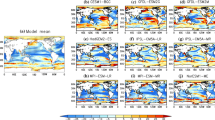Abstract
Ecosystem models, used mainly in studying the interactions between different trophic levels, can also be used for ocean circulation model skill assessment, with the help of satellite ocean color data. This paper presents how the use of a simple NPZ primary productivity ecosystem model, coupled to a hydrodynamical model, can help assessing the skill of the physical ocean model in depicting realistically the prevailing mesoscale features of the upper layers of the Gulf of Mexico. Results indicate that the physical model effectively reproduces the mesoscale features of circulation underlying the resulting chlorophyll concentrations, especially when circulation fronts exist.
Similar content being viewed by others
References
Carniel S., Umgiesser G., Kantha L.H., Monti S. and M. Sclavo, 2002. Tracking the drift of a human body in the coastal ocean using Numerical Prediction Models of the oceanic, atmospheric and wave conditions. Science & Justice, 42(3), pp. 143–151
Forristall, G.Z., K.J. Schaudt, C.K. Cooper, 1992. Evolution and kinematics of a Loop Current Eddy in the Gulf of Mexico during 1985, J. Geophys. Res., 97, 2173–2184.
Rixen M., Book J.W., Carta A., Grandi V., Gualdesi L., Stoner R., Ranelli P., Cavanna A., et al., 2009. Improved ocean prediction skill and reduced uncertainty in the coastal region from multi-model super-ensembles. Journal of Marine Systems, 78, S282–S289. DOI: 10.1016/j.jmarsys.2009.01.014
Kantha, L.H., 2005. Development, testing and implementation of a real-time nowcast/forecast capability for the Gulf of Mexico, Monthly Kaiyo (Japan), 37, 239–256.
Taillandier V., Griffa A., Poulain P.-M., Signell R.P., Chiggiato J. and S. Carniel, 2008. Variational analysis of drifter positions and model outputs for the reconstruction of surface currents in the Central Adriatic during fall 2002. Journal of Geophysical Research — Ocean, 113, C04004. DOI: 10.1029/2007JC004148
Kantha, L.H., J.-K. Choi, K.J. Schaudt and C.K. Cooper, 2005. A regional data-assimilative model for operational use in the Gulf of Mexico, in Circulation in the Gulf of Mexico: Observations and Models, eds. W. Sturges and A. Lugo-Fernandez, American Geophysical Union, 165–180.
Brooks, D.A., and R.V. Legeckis, 1982. A ship and satellite view of hydrographic features in the Gulf of Mexico. J. Geophys. Res., 87, 4195–4206.
Kuznetsov, L., M. Toner, A.D. Kirwan, Jr., C.K.R.T. Jones, L. Kantha and J. Choi, 2002, The Loop Current and adjacent rings delineated by Lagrangian analysis of the near-surface flow. J. Mar. Res., 60, 405–429.
Toner, M., A.D. Kirwan, Jr., A.C. Poje, L.H. Kantha, F.E. Muller-Karger and C.K.R.T. Jones, 2003, Chlorophyll dispersal by eddy-eddy interactions in the Gulf of Mexico. J. Geophys. Res., 108(C4), 3105, DOI:10.1029/ 2002JC001499.
Bignami F., Sciarra R., Carniel S. and R. Santoleri, 2007. The variability of the Adriatic sea coastal turbid waters from SeaWiFS imagery. Journal of Geophysical Research — Ocean, 112, C03S10. DOI: 10.1029/2006JC003518
Kirwan, A.D., Jr., W.J. Merrell, Jr., J.K. Lewis, and R.E. Whitaker, 1984. Lagrangian observations of an anti-cyclonic ring in the western Gulf of Mexico, J. Geophys. Res., 89, 3417–3424.
Choi, J.-K., L.H. Kantha, and R.R. Leben, 1995. “A Nowcast/Forecast Experiment Using TOPEX/Poseidon and ERS-1 Altimetric Data Assimilation Into a Three-Dimensional Circulation Model of the Gulf of Mexico” IUGG, XXI General Assembly, Boulder, Colorado, July 1995.
Onken R., Robinson A.R., Kantha L.H., Lozano C.J., Haley J.P. and S. Carniel, 2005. Inter-model nesting and rapid data exchange in distributed systems. Journal of Marine Systems, 56(1–2), 45–66. DOI: 10.1016/j.marsys.2004.09.010
Hamilton, P., 1992. Lower continental slope cyclonic eddies in the central Gulf of Mexico. J. Geophys. Res., 97, 2185–2200.
Biggs, D.C., 1992. Nutrients, plankton, and productivity in a warm-core ring in the western Gulf of Mexico. J. Geophys. Res., 97, 2143–2154.
Elliott, B.A., 1982. Anticyclonic rings in the Gulf of Mexico, J. Phys. Oceanogr., 12, 1293–1309.
Sturges, W., J.C. Evans, W. Holland, and S. Welsh, 1993. Separation of warm core rings in the Gulf of Mexico, J. Phys. Oceanogr., 23, 250–268.
Vukovich, F.M., and B.W. Crissman 1986. Aspects of warm rings in the Gulf of Mexico. J. Geophys. Res., 91, 2645–2660.
Vukovich, F.M., and G.A. Maul, 1985. Cyclonic eddies in the eastern Gulf of Mexico. J. Phys. Oceanogr., 15, 105–117.
Carniel, S., Vichi, M., and M. Sclavo, 2007. Sensitivity of a coupled physical-biological model to turbulence: high frequency simulations in a northern Adriatic station. Chemistry and Ecology, 23(2), pp. 157–175. DOI: 10.1080/02757540701197903
Kantha, L.H., 2004. A general ecosystem model for applications to primary productivity and carbon cycle studies in the global oceans. Ocean Modeling, 6, 285–334.
Chu, P.C., L.M. Ivanov, and T.M. Margolina, 2007. On non-linear sensitivity of marine biological models to parameter variations. Ecological Modelling, 206, 369–382.
Author information
Authors and Affiliations
Corresponding author
About this article
Cite this article
Kantha, L., Carniel, S., Clayson, C.A. et al. On the use of a simple primary productivity model to assess the skill of a physical ocean model. Ocean and Hydro 40, 86–95 (2011). https://doi.org/10.2478/s13545-011-0019-2
Received:
Accepted:
Published:
Issue Date:
DOI: https://doi.org/10.2478/s13545-011-0019-2




